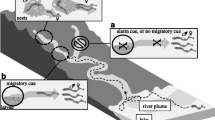Abstract
Stream finding by the anadromous sea lamprey is mediated by a pheromone released by stream-resident larvae which functions as an instinctively recognized indicator of habitat suitability. This cue is comprised of multiple components including the bile acid, petromyzonol sulfate, and at least one other as yet unidentified compound with a molecular weight of 704 daltons. These compounds are detected at picomolar concentrations and are released in large quantities; laboratory experiments demonstrate that each stream-resident larva activates at least 400L of water an hour. The actions of this pheromone are synergized by other compounds found in natural stream waters. Field studies demonstrate that the migratory pheromone plays a key role determining adult lamprey distribution in the Great Lakes. The cue does not appear to be species-specific or specialized, but rather a composite of biologically-relevant compounds that migratory adults have evolved the ability to recognize.
Similar content being viewed by others
References
Bergstedt, R.A. and Seelye, J.G. 1995. Evidence for a lack of homing by sea lamprey. Trans. Amer. Fish. Soc. 124: 235–239.
Bjerselius, R., Li,W. and Sorensen, P.W. 1995. Spermiated male sea lamprey release a potent sex pheromone. In: Proceedings of the Fifth International Symposium on the Reproductive Physiology of Fish, eds. F. Goetz and P. Thomas. pp. 271. Austin, Texas: Fish Symposium 95.
Bjerselius, R., Li, W., Teeter, J.H., Seelye, J.G., Maniak, P.J., Grant G.C., Polkinghorne, C.N. and Sorensen, P.W. 2000. Direct behavioral evidence that unique bile acids released by larval sea lamprey function as a migratory pheromone. Can. J. Fish. Aquat. Sci. 57: 557–569.
Fine, J.M. 2001. Behavioral and biochemical evidence that the sea lamprey migratory pheromone is not species-specific. M.S. thesis, University of Minnesota, St. Paul, MN.
Li, W. and Sorensen, P.W. 1997. Highly independent olfactory receptor sites for naturally occurring bile acids in the sea lamprey, Petromyzon marinus. J. Comp. Physiol. A. 180: 429–438.
Li, W., Sorensen, P.W. and Gallaher, D.G. 1995. The olfactory system of the migratory sea lamprey (Petromyzon marinus) is specifically and acutely sensitive to unique bile acids released by conspecific larvae. J. Gen. Physiol. 105: 569–587.
Li, W., Scott, A.P., Siefkes, M.J., Yan, H., Liu, Q., Yn, S.-S. and Gage, D. 2002. Bile acid secreted by male sea lamprey that acts as a sex pheromone. Science 296: 138–141.
Moore, H.H. and Schleen, L.P. 1980. Changes in spawning runs of sea lamprey (Petromyzon marinus) in selected streams of Lake Superior after chemical control. Can. J. Fish. Aquat. Sci. 37: 1851–1860.
Morman, R.H., Cuddy, D.W. and Rugen, P.C. 1980. Factors influencing the distribution of sea lamprey (Petromyzon marinus) in the Great Lakes. Can. J. Fish. Aquat. Sci. 37: 1811–1826.
Polkinghorne, C.A., Olson, J.M., Gallaher, D.G. and Sorensen, P.W. 2001. Larval sea lamprey release two unique bile acids to the water at a rate which is sufficient to produce a detectable pheromonal plume. Fish Physiol. Biochem. 24: 15–30.
Sorensen, P.W. and Wyatt, J. 2000. Pheromones. In: TheCorsini Encyclopedia of Psychology and Behavioral Science, third edition, eds. W.E. Craighead and C.B. Nemoff, pp. 1193–1195. N.Y., John Wiley and Sons.
Sorensen, P.W. and Stacey, N.E. 1999. Evolutionary specialization of hormonal pheromone production in fishes. In: Advances in Chemical Signals in Vertebrates, eds. R.E. Johnston, D. Müller-Schwarze, and P.W. Sorensen, pp. 15–48, N.Y., Plenum Press.
Sorensen, P.W. and Vrieze, L.A. 2003. Chemical ecology and potential application of the sea lamprey migratory pheromone. J. Great Lakes Res. 29 (Supplement 1): 66–84.
Teeter, J. 1980. Pheromone communication in sea lampreys (Petromyzon marinus): Implications for population management. Can. J. Fish. Aquat. Sci. 37: 2123–2132.
Vrieze, L.A. and Sorensen, P.W. 2001. Laboratory assessment of the role of a larval pheromone and natural stream odor in spawning stream localization by migratory sea lamprey (Petromyzon marinus). Can. J. Fish. Aquat. Sci. 58: 2374–2385.
Author information
Authors and Affiliations
Rights and permissions
About this article
Cite this article
Sorensen, P., Vrieze, L. & Fine, J. A multi-component migratory pheromone in the sea lamprey. Fish Physiology and Biochemistry 28, 253–257 (2003). https://doi.org/10.1023/B:FISH.0000030545.39156.2b
Issue Date:
DOI: https://doi.org/10.1023/B:FISH.0000030545.39156.2b




